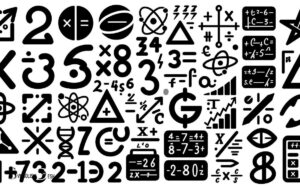Small O Symbol in Math: Little-o Notation!
The small “o” symbol in mathematics typically represents the Little-o notation, which is used in asymptotic analysis to describe the limiting behavior of functions.
The Little-o notation is a way to describe the growth rate of a function relative to another function as the input approaches a specific point, often infinity.
Mathematically, the expression “f(x) = o(g(x))” as x approaches a value c means that f(x) grows much more slowly than g(x), so that f(x)/g(x) approaches zero.
The small “o” symbol is distinct from the Big-O notation (usually denoted by a capital “O”), which is used to describe an upper bound on the growth rate of a function.
For example:
- If f(x) = 3x and g(x) = x^2, then f(x) = o(g(x)) as x approaches infinity, because 3x grows much slower than x^2, and the ratio 3x/x^2 goes to zero.
Bullet points:
In mathematical analysis, the small “o” symbol provides a precise way to describe how one function dwarfs another in growth as inputs increase, crucial for understanding complexities in algorithms.

Key Takeaway
Definition of Small O Notation
The small o notation in mathematics is a quantifier determiner used to denote a function’s growth rate. It is employed to compare the growth of one function to another as the input tends towards a particular value, often infinity.
Formally, for functions f(x) and g(x), f(x) = o(g(x)) as x approaches a certain value, typically signifies that the growth of f(x) is slower than g(x).
In simpler terms, it indicates that g(x) “dominates” the growth of f(x) as x becomes large. This notation is crucial in analyzing algorithms and understanding their efficiency.
By quantifying the rate of growth of functions, it provides insights into how different algorithms perform as the input size increases, aiding in the comparison and selection of the most efficient algorithm for specific tasks.
Properties of Small O Symbol
Describes the behavior of the small o notation in mathematical analysis.
When it comes to the properties of the small o symbol, it’s essential to understand the following:
- Non-negativity: For a function f(x) = o(g(x)), f(x) must be non-negative for all x greater than some constant.
- Limit Condition: The limit of f(x)/g(x) as x approaches a point must equal 0.
- Transitivity: If f(x) = o(g(x)) and g(x) = o(h(x)), then f(x) = o(h(x)).
- Multiplicative Constants: If f(x) = o(g(x)), then kf(x) = o(g(x)) for any non-zero constant k.
Understanding these properties is crucial for leveraging small o notation effectively in mathematical analysis.
Relationship to Big O Notation
In relation to big O notation, the small o symbol represents a stricter growth condition for functions, emphasizing the rate of growth comparison.
While big O notation describes an upper bound on the growth rate of a function, small o notation provides a more precise comparison by indicating that one function grows faster than another without being equal to it.
Mathematically, for a function g(x) to be labeled as o(f(x)), it must grow strictly slower than f(x) as x approaches a certain value, often infinity.
This relationship is crucial in analyzing the efficiency and performance of algorithms and functions in computer science and mathematics.
Understanding the distinction between big O and small o notations is essential for evaluating and comparing the time and space complexities of algorithms and functions.
Applications in Algorithm Analysis
One essential application of the small o notation in algorithm analysis is its role in determining the precise growth rate comparison between functions, aiding in the evaluation of algorithm efficiency and performance.
It allows for a more detailed understanding of how algorithms scale as input sizes increase, enabling informed decision-making in algorithm selection and design.
The applications of small o notation in algorithm analysis include:
- Providing a finer distinction between different growth rates than big O notation.
- Helping in identifying the exact upper bound on the growth rate of a function.
- Assisting in comparing the efficiency of algorithms with similar growth rates.
- Offering insights into the behavior of algorithms for large input sizes.
Understanding these applications of small o notation is crucial for algorithm designers and analysts to make informed choices about algorithm selection and optimization strategies.
Small O in Calculus
The application of small o notation in calculus frequently encompasses the precise analysis of function behavior near specific values and the comparison of growth rates in mathematical contexts.
In calculus, small o notation is used to represent a function’s growth in relation to another function.
When f(x) is small o of g(x) as x approaches a certain value, it signifies that the growth rate of f(x) is negligible compared to g(x) as x approaches that value.
This notation is valuable in analyzing limits, derivatives, and integrals, providing insight into the behavior of functions at specific points.
Small o notation aids in understanding the relative rates of growth of functions and is fundamental in calculus for describing the finer details of function behavior near certain values.
Small O Notation Examples
Examples of small o notation in mathematics illustrate the comparison of function growth rates and provide valuable insights into the behavior of functions near specific values, aiding in the analysis of limits, derivatives, and integrals.
Small o notation is often used in calculus to describe the relationship between functions and their rates of growth or decay.
Here are some common examples of small o notation:
- ( f(x) = x^2 ) and ( g(x) = x^2 + x ) where ( f(x) = o(g(x)) )
- ( f(x) = 2x + 3 ) and ( g(x) = x^2 ) where ( f(x) = o(g(x)) )
- ( f(x) = e^x ) and ( g(x) = x^2 ) where ( f(x) = o(g(x)) )
- ( f(x) = (x) ) and ( g(x) = x ) where ( f(x) = o(g(x)) )
Limitations and Considerations
When using the small o symbol in mathematical contexts, it is essential to consider the nuances of symbol interpretation, as well as the variations in its application within different mathematical contexts.
Additionally, attention should be given to formatting and clarity to ensure the accurate representation of mathematical concepts.
Symbol Interpretation Nuances
As we delve into the nuances of interpreting the small o symbol in mathematical contexts, it is crucial to consider its limitations and special considerations.
When interpreting the small o symbol, the following nuances should be taken into account:
- Asymptotic Behavior: The small o notation describes the behavior of a function as it approaches a limit, emphasizing the rate of growth or decay compared to another function.
- Precision: Careful attention must be given to the precise definition and context of usage to accurately interpret the implications of the small o symbol.
- Comparative Analysis: Small o notation is often used in comparing the growth rates of functions, highlighting the relative growth rates between functions.
- Complexity Analysis: In algorithmic analysis, small o notation is employed to express the upper bounds of complexity to demonstrate the efficiency of algorithms.
Understanding these nuances is essential for correctly interpreting the small o symbol in mathematical expressions.
Mathematical Context Variations
The small o symbol in mathematical contexts exhibits variations and considerations dependent on the specific mathematical context being analyzed.
In some contexts, it represents the order of a function, indicating the growth rate concerning another function. However, in different contexts, it may denote a negligible quantity, particularly when approaching a limit.
Below is a table summarizing the variations and considerations of the small o symbol in different mathematical contexts:
| Mathematical Context | Representation and Meaning of Small o Symbol |
|---|---|
| Asymptotic Analysis | Represents the order of a function’s growth |
| Limits and Continuity | Denotes a negligible quantity as a limit is approached |
| Taylor Series | Indicates the remainder term in a Taylor series expansion |
| Complex Analysis | Represents a function that tends to zero faster than the variable |
Understanding these variations is crucial for accurately interpreting the small o symbol in diverse mathematical contexts.
Formatting and Clarity
Discussing the formatting and clarity considerations in mathematical contexts, it is essential to ensure precision and coherence in the interpretation of the small o symbol.
When using the small o symbol in math, it is important to consider the following formatting and clarity aspects: The small o symbol, also known as the small circle symbol, should be properly sized and centered within the equation to maintain clarity and readability. It is important to ensure that the symbol is not confused with other similar-looking symbols, such as the degree symbol or the symbol for the number zero. Additionally, when using the small o symbol in handwritten equations, it is important to make sure that it is clearly and neatly written to avoid any confusion with other symbols.
- Context: Clearly define the scope and domain of the variables involved.
- Explicit Definitions: Provide clear and explicit definitions of the small o symbol’s usage within the specific mathematical context.
- Avoid Ambiguity: Ensure that the use of the small o symbol does not lead to ambiguity or confusion in the interpretation of mathematical expressions.
- Consistent Usage: Maintain consistency in the application of the small o symbol throughout the mathematical discourse.
Adhering to these considerations will help maintain clarity and precision in the communication of mathematical concepts involving the small o symbol.
Conclusion
In conclusion, the small o symbol in math signifies a significant shift in algorithm analysis and calculus. Its properties and relationship to big O notation are pivotal in understanding the efficiency of algorithms.
While small o notation has its limitations, its applications in analyzing the behavior of functions are undeniable.
Overall, small o notation offers a nuanced understanding of mathematical concepts and is an essential tool for mathematicians and computer scientists alike.






